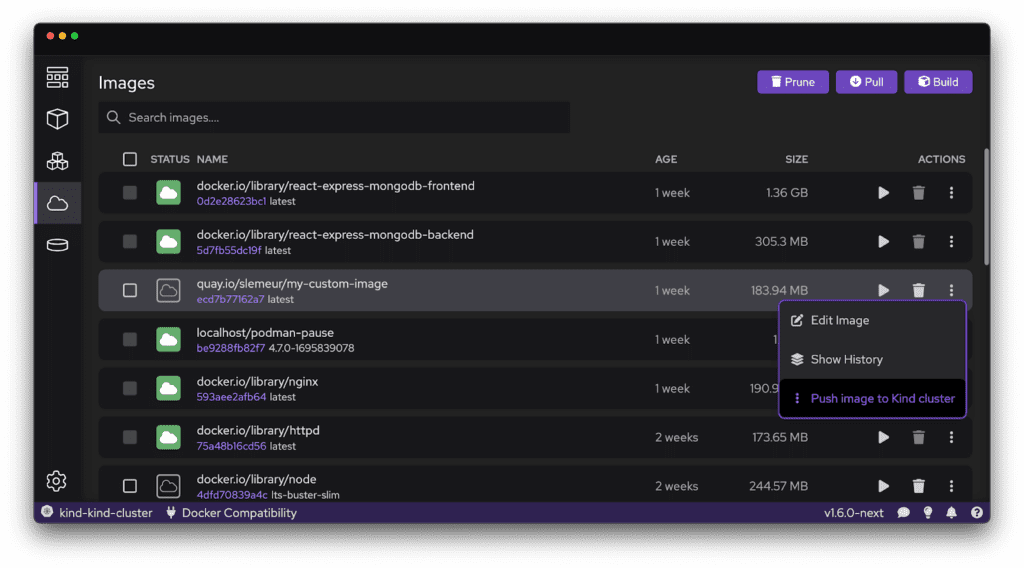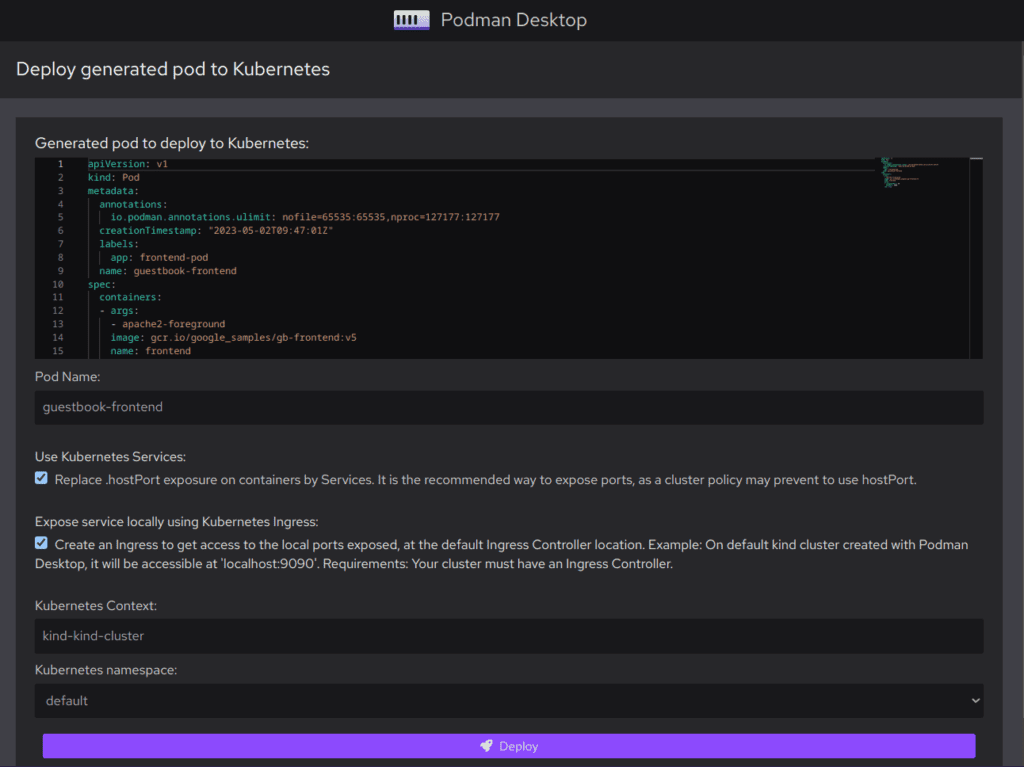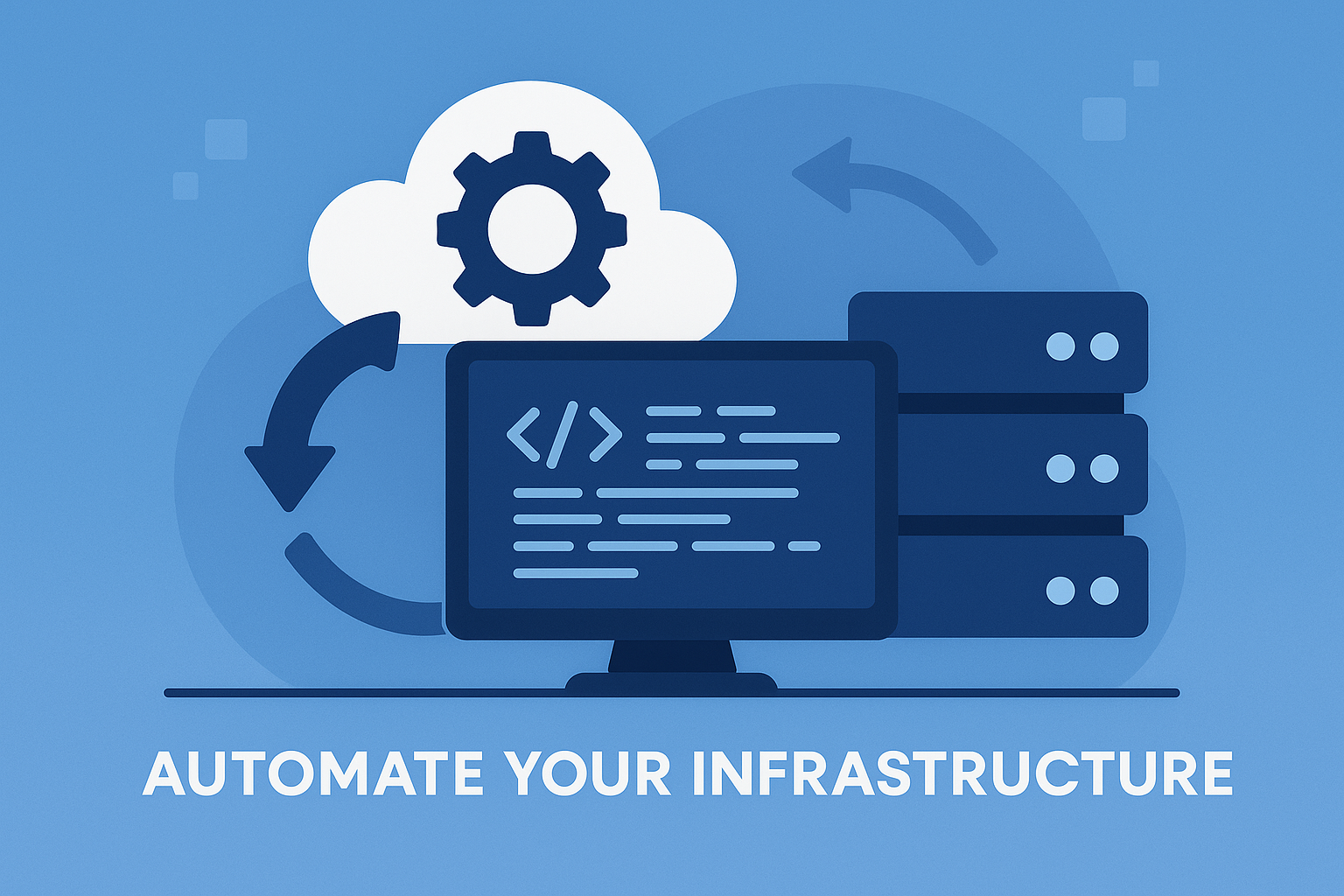Podman Kubernetes: here we take a comprehensive look at utilizing the Podman desktop software to effortlessly create local Kubernetes clusters. Podman desktop is an open-source software that not only facilitates the building of local Kubernetes clusters but also allows the flexibility of building rootless containers, thus eliminating the requirement for a root user. It means you are equipped with the means of creating a secure local environment for your cluster operations, right from your desktop. Irrespective of your use case, be it a complex kind cluster setup or simply running a Podman command, this article will provide a comprehensive and detailed guide for running the setup from scratch. You’ll learn to execute the ‘kubectl create -f’ command, understand the concept of pods and pod metadata, use the docker CLI and Podman CLI interfaces, handle the output of files, manage the network option, among other essential operations.

Understanding Podman and Kubernetes
What is Podman?
Podman is an innovative open-source project developed by Red Hat and contributed to by many other organizations and individual contributors. It was created as a language-agnostic, feature-rich, and Linux-native utility designed to handle the lifecycle and runtime specifics of containers and images.. It provides a command-line interface (CLI) for managing containers and images, similar to Docker. However, unlike Docker, Podman does not require a daemon to run containers. Instead, it uses a rootless mode, making it more secure and lightweight.
Podman provides features like container management, image management, networking, and storage management. It allows you to create, start, stop, and delete containers, as well as perform various operations on container images. With Podman, you can easily manage your containerized applications and services.
What is Kubernetes?
Kubernetes is an open-source container orchestration platform that automates the deployment, scaling, and management of containerized applications. It provides a framework for running and coordinating multiple containers across multiple hosts, ensuring that your applications are highly available and scalable.
Kubernetes organizes containers into logical units called “pods” and manages their lifecycles. It provides features like service discovery, load balancing, self-healing, and rolling updates. With Kubernetes, you can effectively manage and scale your containerized applications, making them more reliable and resilient.
Advantages of Using Podman and Kubernetes
Podman is a lightweight and capable alternative to Docker that provides several notable features. It supports both rootful and rootless operation, allowing for enhanced security. It also employs the use of pods to manage containers, mimicking the Kubernetes model and making it easier to transition microservices to Kubernetes. Another advantage of Podman is its compatibility with Docker’s CLI syntax, making it an easy-to-use tool for existing Docker users.
Using Podman and Kubernetes together offers several advantages for containerized application development and deployment:
-
Portability: Containers created with Podman can be seamlessly run on any Kubernetes cluster, allowing you to easily move your applications between different environments.
-
Scalability: Kubernetes provides built-in scaling capabilities, allowing you to scale your applications up or down based on demand. Podman helps in managing the container images and provides easy tools to build and push images.
-
High Availability: Kubernetes ensures that your applications are highly available by automatically distributing containers across multiple hosts and automatically restarting failed containers.
-
Resource Efficiency: Both Podman and Kubernetes optimize resource utilization by efficiently managing container lifecycles and scaling resources as needed.
-
Simplified Management: Podman and Kubernetes provide powerful management tools and APIs for managing containers and clusters, making it easier to deploy, update, and monitor your applications.
By using Podman with Kubernetes, you can take advantage of the security, flexibility, and scalability of containerized applications while benefiting from the advanced orchestration capabilities provided by Kubernetes.
Setting Up Podman Desktop
Installation on Windows
To install Podman on Windows, follow these steps:
-
Download the Podman installer from the official Podman website.
-
Run the installer and follow the on-screen instructions to complete the installation.
-
Once installed, open the Podman Desktop application and configure the necessary settings.
-
Podman is now ready to use on Windows.
Installation on macOS
To install Podman on macOS, follow these steps:
-
Download the Podman installer for macOS from the official Podman website.
-
Open the downloaded .dmg file and drag the Podman application into the Applications folder.
-
Open Terminal and run the following command to enable Podman on macOS:
podman machine start
-
Podman is now installed and ready to use on macOS.
Installation on Linux
The installation process for Podman on Linux depends on your Linux distribution. Here are general steps to install Podman on Linux:
-
Open a terminal and update your package manager’s repositories:
sudo apt update
-
Install Podman using the package manager:
sudo apt install podman
-
Podman is now installed and ready to use on Linux.
Role of Podman in the Container Engine
Podman is a reliable and secure tool for container engines. It provides a platform to build, manage, and maintain containers and container images. It allows for rootless operation, boosting the security of containerized applications.
Difference Between Rootful and Rootless Podman
Podman affords the advantage of running in two modes: rootful and rootless. Rootful Podman provides full access to all system resources, while rootless Podman allows for containers to be run without root privileges. This crucial difference aids in maintaining security within the local environment, as running containers as a non-root user mitigates potential security risks.
Configuring Podman Desktop
Before using Podman, you may need to configure some settings, such as specifying the default container runtime, managing storage drivers, and setting up network configurations.
To configure Podman Desktop, follow these steps:
-
Open the Podman Desktop application.
-
Go to the Settings menu and navigate to the desired configuration options.
-
Modify the settings as per your requirements.
-
Save the changes and close the settings menu.
Podman Desktop is now configured and ready to use according to your specific preferences.
Understanding Local Clusters
Why Use a Local Cluster?
A local cluster is a cluster environment that runs on your local machine instead of a cloud infrastructure. It provides a platform for developing, testing, and deploying containerized applications in a controlled environment. Using a local cluster has several advantages:
-
Cost-Effective: Running a local cluster eliminates the need for external cloud resources, reducing the associated costs.
-
Speed and Efficiency: With a local cluster, you have faster access to resources and can quickly iterate and test your applications.
-
Isolation: A local cluster provides a dedicated environment for your development and testing purposes, ensuring that your production environment remains unaffected.
-
Flexibility: A local cluster allows you to customize the cluster configuration and experiment with different settings without any restrictions.
Benefits of Local Cluster With Podman Kubernetes
Using Podman Kubernetes for your local cluster offers additional benefits:
-
Compatibility: Podman Kubernetes is fully compatible with the official Kubernetes APIs, ensuring that your applications can seamlessly run on any Kubernetes cluster.
-
Integrated Container Runtime: Podman Kubernetes uses Podman as the underlying container runtime, providing a secure and lightweight alternative to traditional container runtimes.
-
Simplified Cluster Management: Podman Kubernetes simplifies the setup and management of local clusters, making it easier for developers to focus on application development rather than infrastructure management.
-
Native Kubernetes Experience: Podman Kubernetes provides a consistent user experience with standard Kubernetes tooling and workflows, allowing developers to leverage their existing knowledge of Kubernetes.
By utilizing a local cluster with Podman Kubernetes, developers can easily develop, test, and deploy their containerized applications in a controlled environment, accelerating their application development lifecycle.
Working with Podman as a Non-Root User
Benefits and Limitations of Working with Podman as a Non-Root User
Running containers using Podman as a non-root user provides the benefit of enhanced security. However, limitations exist related to restricted resource access and capabilities, hence, requiring careful management.
How to Setup User Namespace Mode in Podman
User namespaces are a feature of Linux that can be used to separate the user IDs and group IDs between host and containers. Setting up the user namespace mode during the Podman setup enhances the secure use of containers.
Service Specification in Podman Kubernetes
How to Create a Kubernetes Service Object in Podman
A Kubernetes service is an abstraction that defines a logical set of Pods. In Podman, Kubernetes service objects can be created using specific CLI commands, which can ensure the systematic deployment and scaling of applications.
Understanding Kubernetes Configmap
Kubernetes ConfigMap is a feature that allows you to decouple configuration artifacts from image content. This abstraction helps in keeping the images portable, making them easy for distribution and deployment using Podman.
Working with Kubernetes Pod YAML
Kubernetes Pod YAML is a human-readable data serialization standard that is commonly used for configuration files. It is a form of representing Kubernetes objects, and Podman provides ways to generate and use these YAML files.
Building and Running a Kubernetes Version of an Application with Podman
To build and run a Kubernetes version of an application, you need to create a Kubernetes YAML file for the application using Podman and deploy it to a Kubernetes cluster.
Preparing Your Environment
Checking System Requirements
Before setting up a local cluster with Podman Kubernetes, ensure that your system meets the following requirements:
-
Operating System: Podman Kubernetes supports Windows, macOS, and Linux operating systems.
-
Hardware Resources: The system should have sufficient CPU, memory, and disk space to run the cluster and deploy applications.
-
Network Connectivity: The system should have an active internet connection to download dependencies and container images.
Installing Required Dependencies
To set up a local cluster with Podman Kubernetes, you need to install certain dependencies depending on your operating system:
For Windows:
-
Install WSL 2: WSL 2 is required for running Linux containers on Windows. Follow the official Microsoft documentation to install and configure WSL 2.
-
Install Podman: Install Podman using the instructions provided in the “Installation on Windows” section.
-
For macOS:
-
Install Docker Desktop: Docker Desktop is required for running Linux containers on macOS. Download and install Docker Desktop from the official Docker website.
-
Install Podman: Install Podman using the instructions provided in the “Installation on macOS” section.
-
For Linux:
-
Install Podman: Install Podman using the instructions provided in the “Installation on Linux” section.
-
Install other dependencies: Depending on your Linux distribution, you may need to install additional dependencies like CRI-O or libvirt. Refer to the official documentation for your distribution for detailed instructions.
-
Setting Up Network Configuration
To ensure proper network connectivity for your local cluster, configure the network settings as follows:
-
Reserve IP Range: Reserve a range of IP addresses for your cluster, ensuring that they do not conflict with any other networks or services. This range will be used for assigning IP addresses to the containers in your cluster.
-
Configure Firewall: Allow incoming and outgoing network traffic on the required ports for your container runtime and Kubernetes components. This ensures that the containers and control plane can communicate with each other.
-
Verify DNS Settings: Ensure that your DNS settings are properly configured to resolve hostnames and domain names within your cluster.
By preparing your environment and configuring the network settings, you are ready to create your local cluster using Podman Kubernetes.
Creating a Local Cluster
Initializing the Cluster
To create a local cluster using Podman Kubernetes, follow these steps:
-
Open a terminal or command prompt.
-
Run the following command to initialize the cluster:
podman cluster init
-
Wait for the cluster initialization process to complete. This may take some time depending on your system resources.
Configuring Cluster Settings
After initializing the cluster, you can configure various settings according to your requirements:
-
Container Runtime: Specify the container runtime to use for the cluster. Podman Kubernetes supports different container runtimes like Podman, Docker, and CRI-O.
-
Network Configuration: Configure the network settings for your cluster, including the IP range, DNS settings, and network policies.
-
Persistence Configuration: Set up persistent storage for your cluster, allowing data to be preserved even if the containers are restarted or redeployed.
-
Authentication and Authorization: Configure user authentication and authorization mechanisms for accessing the cluster and its resources.
By configuring the cluster settings, you can customize the behavior and functionality of your local cluster.
Setting Up Worker Nodes
A local cluster typically consists of multiple worker nodes that run the containerized applications. To set up worker nodes in your local cluster, follow these steps:
-
Open a terminal or command prompt on the machines you want to add as worker nodes.
-
Run the following command on each machine to join it as a worker node:
podman cluster join
Replace with the address of the control node in your cluster.
-
Repeat the above steps for each machine you want to add as a worker node.
Checking Cluster Status
To verify the status of your local cluster, run the following command:
podman cluster status
This command will display the status of all the nodes in the cluster, including the control node and worker nodes.
By creating a local cluster with Podman Kubernetes, you have set up a platform for deploying and managing containerized applications in your development environment.

Deploying Applications on the Cluster
Pulling Docker Images
Before deploying applications on your local cluster, you need to pull the required Docker images. Use the following command to pull an image:
podman pull
Replace with the name of the Docker image you want to pull. Repeat this command for each image you want to use in your applications.
Creating Deployment Manifests
To deploy applications on your local cluster, you need to create deployment manifests that define the desired state of your applications. Deployment manifests are written in YAML format and include details like container specifications, resource requirements, and environment variables.
Here is an example deployment manifest for a simple web application:
apiVersion: apps/v1 kind: Deployment metadata: name: my-app spec: replicas: 2 selector: matchLabels: app: my-app template: metadata: labels: app: my-app spec: containers: – name: my-app-container image: my-app-image:latest ports: – containerPort: 80
In the above manifest, a deployment named my-app is defined with two replicas. The deployment uses a container image my-app-image and exposes port 80.
Create similar deployment manifests for your applications, specifying the necessary details for each container.
Deploying Applications
To deploy your applications on the local cluster, run the following command:
podman apply -f
Replace with the path to your deployment manifest file.
This command loads the deployment manifest and applies it to the cluster, creating the necessary resources and starting the containers.
Repeat this command for each deployment manifest you want to apply to the cluster.
Scaling and Updating Applications
Once your applications are deployed, you can scale them up or down based on demand. To scale an application, use the following command:
podman scale deployment –replicas=
Replace with the name of the deployment you want to scale and with the desired number of replicas.
To update an application with a new container image, update the deployment manifest file and run the podman apply command with the updated manifest.
By deploying, scaling, and updating applications on your local cluster, you can test and iterate on your containerized applications in a controlled environment.
Managing the Cluster
Monitoring Cluster Performance
To monitor the performance of your local cluster, you can use monitoring tools like Prometheus and Grafana. These tools provide metrics and visualizations for monitoring the performance and resource utilization of your cluster.
By monitoring the cluster performance, you can identify any bottlenecks or issues and optimize the resource allocation for your applications.
Managing Nodes
Podman Kubernetes allows you to manage the nodes in your local cluster easily. You can add or remove worker nodes, upgrade node versions, and configure node-specific settings.
To add a new worker node to your cluster, follow the steps mentioned earlier in the “Setting Up Worker Nodes” section.
To remove a worker node from your cluster, run the following command:
podman cluster remove
Replace with the hostname or IP address of the node you want to remove.
Managing Services
In a local cluster, you can expose your applications as services so that they are accessible from outside the cluster. Podman Kubernetes supports multiple service types, including ClusterIP, NodePort, and LoadBalancer.
To create a service, define a service manifest similar to the deployment manifest, specifying the desired service type and target application.
Run the following command to create the service:
podman apply -f
Replace with the path to your service manifest file.
Upgrading and Patching the Cluster
Periodically, you may need to upgrade or patch your local cluster to take advantage of new features, bug fixes, or security updates.
To upgrade the cluster components, follow the instructions provided by the Podman Kubernetes project for your specific version.
To patch the cluster nodes, update the underlying operating system, container runtime, or other dependencies as needed.
By effectively managing the cluster, nodes, and services, you can ensure the smooth operation of your local cluster and the applications running on it.
Troubleshooting Common Issues
Troubleshooting Cluster Initialization
If you encounter any issues during cluster initialization, ensure that:
-
Your system meets the minimum requirements for running Podman Kubernetes.
-
All network configurations are properly set up.
-
There are no conflicts with existing services or firewalls.
-
The cluster initialization command is executed with the necessary permissions.
Debugging Application Deployments
If your applications fail to deploy or encounter errors, you can follow these steps to debug and troubleshoot:
-
Check the logs of the individual containers or pods using the
podman logscommand. -
Check the status of the deployments and services using the
podman get deploymentsandpodman get servicescommands. -
Review the deployment manifest for any errors or misconfigurations.
-
Check the resource utilization of the cluster and individual nodes using monitoring tools.
Resolving Networking Problems
If you experience networking issues within the cluster, check the following:
-
Ensure that the network configurations are correctly set up and that the IP addresses for the containers and services are properly assigned.
-
Check the DNS settings to ensure that hostnames and domain names are properly resolved within the cluster.
-
Verify that the necessary network ports are open and accessible for the container runtime and Kubernetes components.
Handling Resource Constraints
If your applications or nodes experience resource constraints, consider the following:
-
Check the resource utilization of the cluster and individual nodes using monitoring tools.
-
Adjust the resource limits and requests for your application containers to ensure they have sufficient resources.
-
Scale up the cluster by adding more worker nodes to distribute the workload.
By troubleshooting and resolving common issues, you can ensure the smooth operation of your local cluster and keep your applications running smoothly.
Backup and Recovery
Implementing Backup Strategies
To protect your local cluster and the applications running on it, it is essential to implement backup strategies. Here are some considerations:
-
Regularly back up the cluster configurations, manifests, and other critical data.
-
Use backup tools or scripts to automate the backup process.
-
Store backups in a secure and off-site location to protect against data loss.
-
Test the backup and recovery process periodically to ensure its effectiveness.
Recovering from Cluster Failure
In the event of a cluster failure or data loss, follow these steps to recover:
-
Restore the backup data to a new or repaired cluster.
-
Verify the integrity and consistency of the restored data.
-
Start the recovered cluster and validate the functionality of the applications.
By implementing backup strategies and having a well-defined recovery process, you can minimize the impact of cluster failures and ensure the continuity of your containerized applications.
Conclusion
In this comprehensive guide, we explored the concepts of Podman and Kubernetes and discussed their advantages in containerized application development and deployment. We provided step-by-step instructions to set up Podman Desktop on different operating systems and configure it properly. Additionally, we explained why using a local cluster with Podman Kubernetes is beneficial and walked through the process of preparing the environment, creating the cluster, deploying applications, and managing the cluster effectively.
By following the outlined steps and considering the best practices, you can leverage Podman and Kubernetes to build and run containerized applications in a controlled and scalable environment. The combination of Podman and Kubernetes offers a seamless workflow and empowers developers to deliver reliable and scalable applications.
We also discussed troubleshooting common issues, backup strategies, and recovering from cluster failures. It is crucial to have a solid understanding of these topics to ensure the smooth operation and stability of your local cluster.
In conclusion, Podman and Kubernetes provide a powerful containerization and orchestration solution that can revolutionize the way you develop and deploy applications. With their benefits of portability, scalability, and simplified management, Podman and Kubernetes are ideal for modern application development and deployment. Embrace the power of containerization and orchestration with Podman and Kubernetes to take your application development to new heights.
Summary of the Process
To summarize the process of setting up and running a local cluster with Podman Kubernetes:
-
Understand the concepts of Podman and Kubernetes and their advantages in containerized application development and deployment.
-
Install and configure Podman Desktop on your operating system.
-
Recognize the benefits of using a local cluster and understand why Podman Kubernetes is an ideal choice.
-
Verify the system requirements and install the necessary dependencies.
-
Set up the network configuration to ensure proper connectivity within the cluster.
-
Initialize the cluster and configure the settings according to your requirements.
-
Add worker nodes to the cluster to distribute the workload.
-
Deploy your applications on the cluster by pulling the required Docker images and creating deployment manifests.
-
Scale and update your applications as needed to meet the demands of your workload.
-
Monitor the performance of the cluster, manage the nodes, and maintain the services.
-
Troubleshoot common issues related to cluster initialization, application deployments, networking, and resource constraints.
-
Implement backup strategies to protect your cluster and applications, and recover from cluster failures if necessary.
By following these steps, you can successfully set up and run a local cluster with Podman Kubernetes and leverage the power of containerization and orchestration for your application development journey.
Benefits of Using Podman Kubernetes
Using Podman Kubernetes for your local cluster provides several benefits:
-
Compatibility: Podman Kubernetes is fully compatible with the official Kubernetes APIs, ensuring seamless portability of your applications.
-
Integrated Container Runtime: Podman Kubernetes leverages the secure and lightweight container runtime provided by Podman.
-
Simplified Cluster Management: Podman Kubernetes simplifies the setup and management of local clusters, enabling developers to focus on application development.
-
Native Kubernetes Experience: Podman Kubernetes provides a consistent user experience with standard Kubernetes tooling and workflows.
By using Podman Kubernetes, you can harness the power of Kubernetes in a local environment, making it easier and more efficient to develop, test, and deploy containerized applications.
Common Use Cases of Podman Kubernetes
How to Manage Docker Commands with Podman
Podman is designed to be a drop-in replacement for Docker, therefore, you can use its commands to manage Docker containers and images.
Working with Podman Containers in a Virtual Machine
Virtual machines offer isolated computing environments. You can run containerized applications within a virtual machine using Podman, managing them as per your needs.
Using Podman in Place of Docker
Podman provides several features that make it a reliable and secure alternative to Docker, such as the absence of a daemon, better security via rootless operation, and improved compatibility with Kubernetes.
Future Developments
The landscape of containerization and orchestration technologies is continuously evolving. Podman and Kubernetes are no exception and will see further developments in the future. Some potential future developments include:
-
Enhanced Integration: Podman and Kubernetes may see further integration, making it even easier to manage containers and clusters seamlessly.
-
Improved Performance: Efforts will be made to improve the performance of Podman Kubernetes, optimizing resource utilization, and reducing latency.
-
Ecosystem Expansion: The ecosystem around Podman Kubernetes will continue to grow, providing additional tools and integrations to enhance the capabilities of the platforms.
-
Security Enhancements: Podman Kubernetes will continue to focus on security, providing additional features and mechanisms to protect containerized applications.
As the community and adoption of Podman Kubernetes grows, these technologies will continue to evolve, providing more advanced features and capabilities for containerization and orchestration. Stay tuned to the latest developments and explore new possibilities as they arise.




